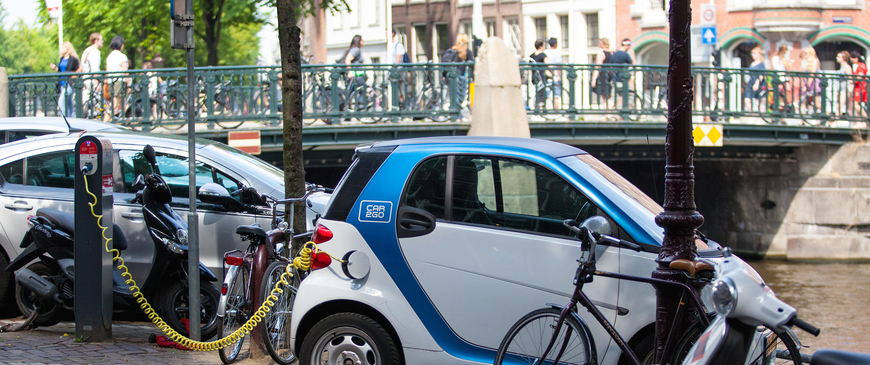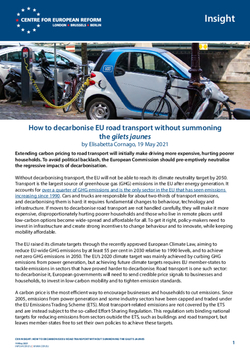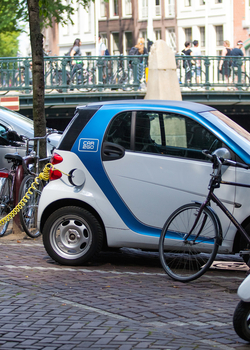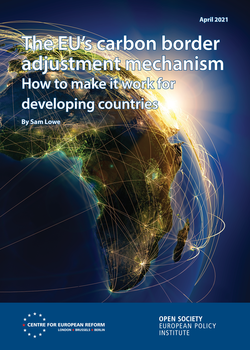
How to decarbonise EU road transport without summoning the gilets jaunes
Extending carbon pricing to road transport will initially make driving more expensive, hurting poorer households. To avoid political backlash, the European Commission should pre-emptively neutralise the regressive impacts of decarbonisation.
Without decarbonising transport, the EU will not be able to reach its climate neutrality target by 2050. Transport is the largest source of greenhouse gas (GHG) emissions in the EU after energy generation. It accounts for over a quarter of GHG emissions and is the only sector in the EU that has seen emissions increasing since 1990. Cars and trucks are responsible for about two-thirds of transport emissions, and decarbonising them is hard: it requires fundamental changes to behaviour, technology and infrastructure. If moves to decarbonise road transport are not handled carefully, they will make it more expensive, disproportionately hurting poorer households and those who live in remote places until low-carbon options become wide-spread and affordable for all. To get it right, policy-makers need to invest in infrastructure and create strong incentives to change behaviour and to innovate, while keeping mobility affordable.
The EU raised its climate targets through the recently approved European Climate Law, aiming to reduce EU-wide GHG emissions by at least 55 per cent in 2030 relative to 1990 levels, and to achieve net zero GHG emissions in 2050. The EU’s 2020 climate target was mainly achieved by curbing GHG emissions from power generation, but achieving future climate targets requires EU member-states to tackle emissions in sectors that have proved harder to decarbonise. Road transport is one such sector: to decarbonise it, European governments will need to send credible price signals to businesses and households, to invest in low-carbon mobility and to tighten emission standards.
To achieve climate targets, EU member-states must tackle emissions from road transport. This requires governments to set up credible price signals, to invest in low-carbon mobility and to tighten emission standards.
A carbon price is the most efficient way to encourage businesses and households to cut emissions. Since 2005, emissions from power generation and some industry sectors have been capped and traded under the EU Emissions Trading Scheme (ETS). Most transport-related emissions are not covered by the ETS and are instead subject to the so-called Effort-Sharing Regulation. This regulation sets binding national targets for reducing emissions from sectors outside the ETS, such as buildings and road transport, but leaves member-states free to set their own policies to achieve these targets.
That may be about to change. The Commission’s forthcoming ‘Fit for 55’ package aims to support decarbonisation with new and updated EU policies. As part of the planned reform of the ETS, European Commission President Ursula von der Leyen confirmed at the US-led climate summit on April 22nd that emissions trading will be expanded to cover emissions from transport and buildings, if member-states agree. The ETS already includes air travel within the EU and will be expanded to cover maritime transport. But policy-makers had hesitated to include road transport because it is politically sensitive: few households regularly fly, but many rely on their cars for their daily commutes and errands.
Information on how the Commission might include road transport in the ETS is still limited, but Commission officials have hinted that the EU might create a separate emissions trading mechanism for sectors for this purpose. That would allow a lower carbon price for road transport, reflecting the fact that zero-carbon transport technology is not yet entirely mature or pervasive. The new mechanism could be linked to the original ETS so that the prices from both mechanisms converge over time. In the longer run, all sectors could be merged in a single ETS. Regardless of specific design choices, the purpose of expanding carbon pricing is to ensure that GHG emissions from road transport are not free of charge – so it will inevitably increase the cost of driving fossil-fuelled vehicles.
The expansion of carbon pricing is not the only forthcoming reform directly affecting road transport. The Commission is also preparing to revise the energy taxation directive. Energy taxes apply to motor fuel, heating fuel and electricity, hitting consumers at the pump and in their utility bills. They are very heterogeneous across countries, sectors and energy products, and between industry and households. For example, aviation and maritime transport are exempt from energy taxation, while road transport is not. As a result, energy taxation does not always hit the most polluting fuels the hardest, which weakens incentives to cut emissions. The reform of the energy taxation directive aims to change that, and to make sure that tax levels and principles are in line with the goals of the European Green Deal. Commission officials have suggested that the reform will remove existing tax exemptions and fossil fuel subsidies, rather than increasing average tax rates.
The Commission will table the proposals to extend carbon pricing to road transport and to reform energy taxation simultaneously in mid-July. Several problems are likely to emerge during discussions:
- First, making EU-wide carbon pricing the centrepiece of road transport decarbonisation will shift responsibility for emission reduction from national to EU level. This shift might reduce pressure on member-states to push through the additional policy changes needed to decarbonise transport, which would be counterproductive. National-level policies also need to be aligned with climate targets. Governments can address road congestion, air pollution and emissions through price signals to road users, such as tolls based on the distance travelled and car registration fees based on vehicle weight and GHG emissions. Local-level interventions matter too – think about congestion charges and parking fees. Governments should remove distorting fiscal incentives such as tax credits for corporate cars: they are at odds with climate action goals and regressive in nature, since they primarily benefit higher-income individuals.
- Second, while revenues from fuel taxes flow into national coffers, revenues from the current ETS are, to some extent, redistributed across countries. In addition, the Commission is proposing to retain part of these revenues for the EU budget. While national governments might be keen to shift the blame for higher fuel prices to ‘Brussels’, they may not relinquish a source of revenue so easily.
- Third, a single EU-wide carbon price for road transport may be more efficient, but it will affect countries unequally. Because, say, Bulgaria and Denmark have different national fuel tax rates, infrastructure systems, public transport coverage and consumer purchasing power, the impact of the same carbon price on the citizens of the two countries would be very different. As fuel taxation is unlikely to be entirely replaced by carbon pricing, the Commission and national governments have to negotiate and design the two policies to ensure that the overall burden of national fuel taxes and EU carbon prices is politically acceptable to consumers.
- Fourth, and perhaps the biggest concern: the increased cost of driving will disproportionately hurt lower-income households and those in poorly connected areas. Poorer households are less able to buy a more fuel-efficient or electric car, and people who live in the countryside cannot easily switch to public transport. Those who work outside normal hours will struggle. The most vulnerable households would need to be protected from price spikes at the pump. France offers a cautionary tale: when it introduced a carbon-based component into fuel taxation in 2014, it chose to reduce other components of the fuel tax to soften its impact. Even so, that did not prevent widespread protests by the gilets jaunes once fuel taxes increased in 2017-2018.
There are ways to make carbon pricing a progressive rather than regressive policy tool. Now is the time for both the EU and its member-states to invest in low-carbon mobility, to ensure that consumers have affordable alternatives to fossil-fuelled cars once carbon pricing takes effect and implicit fuel subsidies are removed. Sustainable transport – from urban public transport and railways to electric vehicles and charging stations – is a flagship area for investment under the EU Recovery and Resilience Facility, a fund set up in response to the COVID-19 pandemic: member-states should make good use of this new budget line to connect the creation of infrastructure jobs, needed for the short-term recovery, with efforts to achieve the long-term low-carbon transition.
Once carbon pricing takes effect, the revenues can be used for unconditional income support to the entire population through ‘carbon dividend’ cheques – which may also increase public approval for carbon pricing. Canada has adopted this approach. Alternatively, the revenues could be channelled into an ‘affordable transport fund’, to be redistributed specifically to lower-income households. This would be a more targeted and effective approach to addressing distributional concerns. As electric vehicles become cheaper and more ubiquitous, the burden of carbon pricing on household transport expenditure will be reduced and this type of fund should eventually become unnecessary.
There are ways to make carbon pricing a progressive rather than regressive policy tool. Its revenues should be redistributed specifically to lower-income households – as opposed to unconditional carbon dividend cheques.
The EU should also channel part of its carbon pricing revenues into a fund for sustainable transport investment in lower-income regions. The money could finance recharging stations for electric vehicles, and expanded and electrified local public transport. It could also finance subsidies for household investment, such as financial incentives to replace fuel-inefficient cars with electric vehicles, public transport passes or cargo bikes. This approach would be in line with current practices under the ETS, part of the revenues from which go to a targeted fund to finance energy sector modernisation in lower-income member-states.
Changes in behaviour and investment in innovation can also be encouraged through regulation. Stronger carbon price signals affecting road transport would complement sectoral regulatory standards for CO2 emissions that are already in place. Those standards should not be loosened as a result of the introduction of carbon pricing. As part of the Fit for 55 package, the Commission will propose increasingly stringent CO2 emissions standards for cars and vans. EU-wide regulation of vehicle CO2 emissions was first introduced in 2012 following the failure of voluntary agreements with car manufacturers to deliver fuel efficiency improvements. Since their introduction, EU standards have become more ambitious, but they still allow heavier vehicles such as SUVs to emit proportionally more CO2 than lighter ones. The share of SUVs in the car fleet has increased over the past decade, contributing to higher GHG emissions and air pollution from road transport. New emission standards should be made more stringent for heavier vehicles, and should lead to the sunset of fossil-fuelled vehicles.
The biggest obstacle to the decarbonisation of road transport is political: the costs of the shift will fall unevenly on different income groups and EU member-states, thus risking the growth of resentment. In reforming carbon pricing and energy taxation, the Commission should design these policies so that extra costs are shared in a way that citizens see as fair. People will need to experience positive changes, in the form of investments in expanded access to low-carbon transport options such as public transport, electric vehicles or bike schemes, before governments price them out of their fossil-fuelled vehicles as a prelude to banning them. Because of this urgency, it is important that governments strongly increase their investment in low-carbon transport now, while also taking advantage of the Recovery and Resilience Facility. Both EU and national policy-makers need to summon pedestrians, cyclists and electric vehicles onto the streets, while denying the gilets jaunes any excuse to join them.
Elisabetta Cornago is a research fellow at the Centre for European Reform.




Add new comment